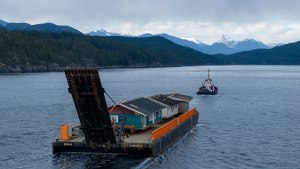When Ministry of the Environment staff called for bids to remediate the largest site of PCB-contaminated soils in Ontario, they posed an unusual challenge: contain any related dust and runoff.
London, On
When Ministry of the Environment staff called for bids to remediate the largest site of PCB-contaminated soils in Ontario, they posed an unusual challenge: contain any related dust and runoff.
They say nearby businesses and a daycare motivated the precautions. The solution?
Put temporary buildings over it, says a project manager with Quantum Murray LP, the contractor that has landed the $63.5 million project.
Larry Rodricks says his company will erect two buildings on the 11-acre site in London. One will measure 50 metres by 70 metres and the other 55 metres by 285 metres, the equivalent of three football fields.
Coverall, a company that specializes in buildings made of fabric with steel frames, is supplying the structures.
“The buildings provide an assurance that we won’t have any releases of dust from the operations,” says Rodricks. “The other added benefit of the building is storm water and erosion control. We won’t have any rainwater coming in contact with any of the vault material as we progressively open up the vaults.”
Under the shelter of these buildings the contractor will remove 78,000 tonnes of PCB-contaminated soils in four storage vaults with the assistance of its engineering consultant, CH2M Hill. Laidlaw trucks will transport the material to a Bennett Environmental Inc. facility in Quebec for treatment.
“In terms of the movement of soil, we’ve done much larger projects before,” says Rodricks. What’s new “are the control mechanisms.”
The ministry ordered Westinghouse Canada to establish the storage site after contaminants found in a nearby creek were traced to the plant where the company manufactured electric transformers. In 1992 its then-Swiss owners, Asea Brown Boveri, shut the plant.
The ministry acquired the storage site in 1985 and used it to hold PCB-contaminated soils from other locations.
Todd Fleet, the ministry’s project lead, says the province’s commitment to the reduction of toxins in the environment and a new federal regulation concerning PCBs are what sparked the decision to rehabilitate the site. The federal regulation requires PCBs already in storage to be removed and destroyed by Dec. 31.
Polychlorinated biphenyls (PCBs) are a group of chemicals once widely used as ingredients in several industrial materials. Exposure to PCBs poses health risks, including an increased incidence of some forms of cancer. They are described as “toxic” under the Canadian Environmental Protection Act.
Along with the roof, several other precautions are being taken to minimize the risk.
Asphalt roads will be built so trucks enter and leave without tracking dirt from the site. Trucks will remain on the roads, Rodricks says. Excavation equipment will bring the soil to the trucks for loading. When trucks leave, they’ll be brushed clean then washed at an on-site truck wash.
About 30 people are working on the project. A crew of eight working on-site will be given health and safety training and “the necessary protection,” Rodricks says. CH2M Hill will monitor dust and air quality as well as sample ground and storm water.
Keeping the public apprised of progress is another unusual feature.
The project marks one of the first times the ministry has opened up a request for proposals for public feedback before being finalized, says Natalie Champagne, a ministry spokesperson. The project has its own community liaison group and Quantum will host public information sessions throughout.
The contractor has until Dec. 11 to complete the removal and until the fall of 2010 to conduct an environmental investigation of the site and restore it to industrial use standards.
After that “we’re unsure what’s going to happen,” Fleet says. “Probably the most attractive option is to put it (the property) up for sale.”
Rodricks says Quantum Murray welcomed the outline of safety precautions on the ministry’s request for proposal. “Often we’re working through those issues after the contract is awarded.”
The level of public engagement “is certainly something we’re taking away from this,” he adds.










Recent Comments
comments for this post are closed